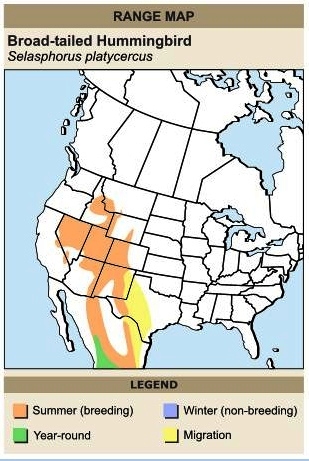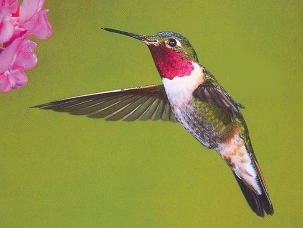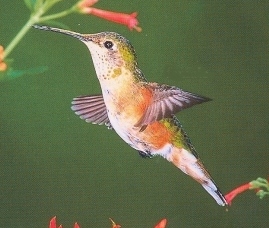|

Medium hummingbird
with green upperparts and flanks, iridescent red throat, and gray underparts.
Dark green tail may show some rufous. Black bill is long and straight.
Black legs, feet. Feeds on nectar, spiders, sap and insects. Direct and
hovering flight with very rapid wing beats.

|
BROAD-TAILED
HUMMINGBIRD
Selasphorus platycercus
APODIFORMES
Hummingbirds (Trochilidae)
Range and Habitat
Breeds in the mountains from eastern California and northern Wyoming
through the Great Basin and Rocky Mountain states to southern Arizona
and western Texas. Spends winters in Mexico. Preferred habitats include
mountain meadows, pinyon-juniper woodlands, dry ponderosa pines, fir
or mixed forests, and canyon vegetation.
SOUND: "chip", "chick", "chitter chitter chitter"

The Broad-tailed Hummingbird enters torpor, a slowed metabolic state,
on cold nights. It maintains a body temperature of about 54° when
ambient temperatures fall below 44° F.
One female holds the North American age record for hummingbirds, at
twelve years old.
Accounts of this species mention that it nests in the same tree or bush
year after year, a phenomenon known as philopatry-faithfulness to the
previous home area. It will return to the same branch and even build
a new nest atop the old one.
A group of hummingbirds has many collective nouns, including a “bouquet",
"glittering", "hover", "shimmer",
and "tune” of hummingbirds.
The Broad-tailed Hummingbird has a large range, estimated globally at
700,000 kilometers. It is native to North America and Guatemala and
prefers subtropical or tropical forests, shrublands, or grasslands as
well as former forests.

|